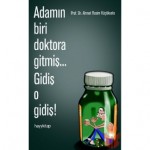MODERN TIBBIN YANLIŞLARI: STATİNLER VE KOLESTEROL-KALP HİPOTEZİ

Donald W. Miller’ in “Fallacies in Modern Medicine: Statins and the Cholesterol-Heart Hypothesis” balıklı yazısı:
Modern medicine has developed striking ways to treat
coronary heart disease, which feature coronary stents
implanted percutaneously and coronary artery bypass grafts
performed surgically with the aid of a heart-lung machine.
And then there are statins to lower cholesterol.
A 70-year-old man sees a physician for a checkup. He
has no history of heart disease and no risk factors for it. He
does not smoke, has no family history of diabetes or heart
disease, and is physically active and not overweight. His blood
pressure is 130/70. A lipid panel, however, shows that his
calculated low-density lipoprotein cholesterol (LDL-C) is 195
mg/dL. Following the most recent 2013 guidelines framed by
an American College of Cardiology (ACC) and American Heart
Association (AHA) task force, the physician prescribes a statin
for this person, rosuvastatin (Crestor) 20 mg/day, for primary
prevention of atherosclerotic cardiovascular disease (ASCVD).1
Cardiologists declare that “cholesterol-containing
lipoproteins are central to the pathogenesis of
atherosclerosis.”2
Statins, first approved for clinical use in
1987, are very effective in lowering cholesterol. High-intensity
statin therapy, rosuvastatin 20mg/day or atorvastatin (Lipitor)
40-80 mg, reduces LDL-C by 50 percent or greater. Moderateintensity therapy, rosuvastatin 10 mg, atorvastatin 10 mg,
simvastatin (Zocor) 20-40 mg, or pravastatin (Pravachol) 40
mg/day, achieves a 30 to 50 percent reduction of LDL-C.3
Some 43 million Americans take statins.4
In 2010,
11.6 percent of the population took them, 37 million, which
includes 19.2 percent of people age 45-64; 39.6 percent of
people age 65-74; and 44.3 percent of people age 75 and
older.3
Following the 2013 ACC/AHA guidelines, an additional
10.2 million Americans without cardiovascular disease, like the
patient above, have now become candidates for statin therapy.5
One study concludes that 97 percent of black and white
Americans age 66 to 75, including all men in that age group,
should take statins.6
It is a multibillion-dollar business. Pfizer’s Lipitor went on
sale in 1997 and became the best-selling drug in the history
of prescription pharmaceuticals before its patent expired
in 2011. Sales surpassed $125 billion. AstraZeneca’s Crestor
was the top-selling statin in 2013, generating $5.2 billion in
revenue that year.
Pfizer, in an advertisement, proclaims: “Lipitor reduces
risk of heart attack by 36%,” based on the findings of a large
randomized trial in which 10,305 individuals were assigned to
take Lipitor or a placebo (ASCOT-LLA).7
The trial showed that
1.9 percent of people taking Lipitor suffered a heart attack
while 3.0 percent of the placebo group had one.
Considered in terms of “relative risk” reduction, the
percentage Pfizer cites in the ad is correct. (It is calculated
by subtracting 1.9 from 3 and dividing the difference, 1.1, by
3, which equals 36 percent.) But more realistically, the trial
showed that Lipitor only reduced the “absolute risk” of having
a heart attack by a tiny 1.1 percent (1.9 percent in the statin
group compared with 3 percent in the placebo group).7
Statintrial investigators tout relative risk reduction (typically 20–40
percent in these trials) rather than the meager, real-world
reduction in risk (1–2 percent in those taking statins).
Investigators cite relative risk to inflate claims of statins’
effectiveness. However, they report deleterious effects in terms
of absolute risk, minimizing their magnitude. For example, if 6
percent of the statin group were to get diabetes during a trial
compared to 2 percent with the placebo group, they will say
that taking statins increases the risk of acquiring diabetes by 4
percent, not that there is 66 percent increased (relative) risk of
suffering this adverse event.
Government and the pharmaceutical industry fund these
multimillion-dollar studies expecting correct results, so statin
trial researchers employ this particular kind of statistical
deception to create the appearance that statins are effective
and safe.8
As one medical school professor puts it, “Anyone
who questions cholesterol usually finds his funding cut off.”9
Eukaryotic animal cells make cholesterol through the
“mevalonate pathway.” This pathway also produces, among other
things, coenzyme Q10 (CoQ10), heme-A, and dolichol. CoQ10
is particularly important as it functions both as an antioxidant
and, with heme-A, in aerobic cellular respiration—in the electron
transport chain that generates adenosine triphosphate (ATP), the
fuel that powers all living things. (Dolichol is required for synthesis
of glycoproteins.) Statins inactivate hydroxymethylglutarylcoenzyme A (HMG-CoA) reductase, the enzyme cells use to
synthesize mevalonate from HMG-CoA. This shuts down the
mevalonate pathway. As a result, HMG-CoA reductase inhibitors
(statins) block not only the synthesis of cholesterol, but also
CoQ10 and the other physiologically essential biomolecules that
this pathway produces.
Lovastatin (Mevacor), the first statin, is a naturally occurring
molecule isolated from a fungus named Aspergillus terreus.
Newer statins are synthetic variations of these mycotoxins
that fungi produce. Fungi make statins, as a “secondary
metabolite,” to kill predatory microbes. They also kill human
cells. In a review of How Statin Drugs Really Lower Cholesterol
and Kill You One Cell at a Time by James and Hannah Yoseph,
Peter Langsjoen writes:
Many practicing physicians have a healthy understanding of the current level of corruption and
collusion among big pharmaceutical companies,
governmental agencies such as the NIH and FDA,
and major medical associations such as the American
Heart Association, but the reader of this book will
come away with the disturbing conclusion that it is
even worse than imagined. Statins may be the perfect
and most insidious human toxin in that adverse
effects are often delayed by years and come about
gradually. Further, statins frequently impair mental
function to such a degree that by the time patients
are in real trouble, they may lack the mental facilities
to recognize the cause.10
This toxin targets brain cells and skeletal muscle. The brain
makes up 2 percent of body weight but contains 25 percent of
the body’s cholesterol. Its dry weight is 50 percent cholesterol.
LDL-C delivers cholesterol to the body’s cells, except for the
brain since this cholesterol-carrying lipoprotein does not
cross the blood-brain barrier. Statins do. Brain cells, neurons
and glial cells, manufacture their own cholesterol and the
mevalonate pathway’s other products.11 A broad spectrum
of adverse cognitive reactions occur from taking statins. They
include confusion, forgetfulness, disorientation, memory
impairment, transient global amnesia, and dementia.12
Myopathy is the most common adverse effect of statin
treatment, manifested by muscle aches and pains, weakness,
instability, and easy fatigue.8,13 The most severe manifestation
of statin-induced muscle damage is rhabdomyolysis, which
carries a 10 percent mortality rate. Fragments of ruptured
muscle block renal tubules and cause kidney failure.12 In one
randomized trial of 1,016 healthy men and women given
statins or a placebo, 40 percent of the women taking statins
suffered exertional fatigue or decreased energy.14
Several randomized controlled trials have reported a
statistically significant increase in cancer associated with
taking statins.8,15 In most of these trials, a small reduction in
cardiovascular deaths in the statin group is counterbalanced
by an increase in deaths from other causes, notably cancer,
with the result that there is in no significant difference in allcause mortality between people taking a placebo and those
prescribed statins.16
Statins can also cause diabetes, emotional disorders
(depression, aggressiveness, suicidal ideation), hepatitis,
cataracts, and strokes.12,13,17 In January 2014 the FDA issued
new safety information on statins, pointing out that “a small
increased risk of raised blood sugar levels and the development
of type 2 diabetes have been reported with the use of statins”;
and it required drug companies to add this information in the
package insert with the drug.18 Since then (as of August 2014),
attorneys have filed more than 1,000 lawsuits against Pfizer,
representing 4,000 women who say that taking Lipitor gave
them diabetes.
Statin trials typically run for only 2 to 5 years. Investigators
terminated the influential JUPITER trial endorsing statins for
primary prevention of ASCVD after (a median) 1.9 years, fartoo short a time to reveal one of the worst “side effects” of
long-term statin treatment: accelerated senescence.19 Statins
speed up the transition from midlife vigor to debilitated old
age.12
Heart surgeon Michael DeBakey and his team, 52 years
ago, found no correlation between blood cholesterol levels
and severity of atherosclerosis in 1,700 patients undergoing
surgical treatment of ASCVD.20 I have observed the same thing
with my heart surgery patients (unpublished observation).
Evidence for the cholesterol-heart hypothesis, i.e., the lipid
hypothesis, wilts upon close scrutiny, as is also the case with
the diet-heart hypothesis, which indicts saturated fat along
with cholesterol for causing atherosclerosis. Approached
with an open mind and without confirmatory bias (ignoring
evidence that disagrees with one’s beliefs), substantial
evidence now proves beyond a reasonable doubt that these
hypotheses are wrong.21-25
If not cholesterol, what causes atherosclerosis? My
colleague, the late Russell Ross, professor of pathology
at the University of Washington, discovered the cause:
Atherosclerosis is an inflammatory disease.26 Initiated by
endothelial dysfunction, with or without injury, and mediated
by macrophages and T lymphocytes, the ensuing inflammatory
response promotes proliferation and migration of smooth
muscle cells. Russell demonstrated that atherosclerosis is
a chronic inflammatory and fibroproliferative process that
is fundamentally not different from that seen in cirrhosis,
rheumatoid arthritis, and chronic pancreatitis.
The small benefit statins offer in dealing with ASCVD comes
from their non-lipid-lowering anti-inflammatory effects,
especially with their ability to suppress nuclear factor-kappa B
(NF-kB), a transcription factor concerned with intensifying the
inflammatory response.27 But even if they had no harmful side
effects, the “number needed to treat” (NNT) for statins weighs
against their use. If a statin reduces the (absolute) risk of
having a heart attack by just 2 percent, its NNT is 50. For every
50 people taking a statin, 1 person will benefit while 49 other
people (98 percent) will not gain any benefit from taking the
drug and will expose themselves to the potentially serious
broad spectrum of adverse events that statins cause (carrying
a risk considerably greater than 2 percent). Statins do more
harm than good. (Nutraceuticals curcumin and resveratrol
also quell inflammation, like statins, by suppressing NF-kB—
with no side effects).
A catalog of factors that play a causal role in inflammatory
ASCVD would include: 1) eating trans-fats and too many
carbohydrates and omega-6 vegetable oils (and not
enough saturated fats); 2) deficiencies in various vitamins
(vitamins A, C, D, E, K2, B6, B9-folic acid, and B12); 3) mineral
deficiencies (magnesium, selenium, copper) and excess (iron);
4) lipid oxidation products; 5) possibly bacterial infection
(Chlamydia pneumoniae); 6) diabetes; 7) abdominal obesity; 8)
hypertension; 9) smoking; and 10) stress.
Cholesterol combats inflammation in addition to its other
roles, which include maintaining cell membrane integrity (cell membranes are 50 percent cholesterol), facilitating
cell signaling, and serving as the structural foundation for
bile salts, various hormones, and vitamin D. Dealing with
inflammation, cholesterol acts as the body’s fire brigade,
putting out inflammatory fires and helping repair damage.
Blaming cholesterol for atherosclerosis is like blaming firemen
for the fire they have come to put out.
Cementing this molecule’s physiologic importance, there
are now more than 100 peer-reviewed studies showing that
low cholesterol levels are associated with earlier death.28 One
of them is a study by Schatz and colleagues exploring the
relationship between cholesterol levels and death rates over
a 20-year period in 3,572 men aged 71-93 years. Those with
the lowest cholesterol had a 35 percent increase in mortality
compared with the highest cholesterol.29 Another one,
following 490 people aged 75 years for more than six years,
found that those with cholesterol levels below 193 mg/dL had
a 52 percent increase in death rates compared with those with
cholesterol levels above 232 mg/dL. Death rates rose by 18
percent for every 38mg/dL decrease in cholesterol levels.30
It is becoming increasingly clear that the cholesterolheart hypothesis is a fallacy of modern medicine. In the
future, medical historians may liken the prescribing of statins
to lower blood cholesterol with the old medical practice
of bloodletting. Taking that vital substance out of the body
is comparable to today’s practice of blocking production of
cholesterol, an equally vital component, with drugs.
Donald W. Miller, Jr., M.D., is emeritus professor of surgery and former
chief, Division of Cardiothoracic Surgery, University of Washington School of
Medicine. Contact: donaldwmiller@gmail.com.
REFERENCES
1. Stone NJ, Robinson JG, Lichtenstein AH, et al. 2013 ACC/AHA guideline
on the treatment of blood cholesterol to reduce atherosclerotic
cardiovascular risk in adults: a report of the American College of
Cardiology/American Heart Association Task force on Practice
Guidelines. J Am Coll Cardiol 2014;63:2889-2934.
2. Kohli P, Whelton SP, Hsu S, et al. Clinician’s guide to the updated ABCs
of cardiovascular disease prevention. J Am Heart Assoc 2014;3:e001098
Available at: http://jaha.ahajournals.org/content/3/5/e001098.full.
Accessed Mar 17, 2015.
3. Newsom LD. Primary prevention of atherosclerotic cardiovascular
disease: controversies and clinical considerations. Ann Pharmacother
2015;49(April):484-493.
4. Pencina MJ, Navar-Boggan AM, D’Agostino RB, et al. Application of
new cholesterol guidelines to a population-based sample. N Engl J Med
2014;370:1422-1431.
5. Centers for Disease Control and Prevention. Health United States, 2013:
With Special Feature on Prescription Drugs. Available at: http://www.cdc.
gov/nchs/data/hus/hus13.pdf. Accessed Mar 20, 2015.
6. Miedema AMD, Lopez FL, Blaha MJ. Eligibility for statin therapy according
to new cholesterol guidelines and prevalent use of medication to lower
lipid levels in an older US cohort: the atherosclerosis risk in communities
study cohort. JAMA Intern Med 2015;175:138-140.
Sever PS, Dahlof B, Poulter NR, et al. Prevention of coronary and stroke
events with atorvastatin in hypertensive patients who have average
or lower-than-average cholesterol concentrations, in the AngloScandinavian Cardiac Outcomes Trial-Lipid Lowering Arm (ASCOT-LLA):
a multicenter randomized controlled trial. Lancet 2003;361:1149-1158.
8. Diamond DM, Ravnskov U. How statistical deception created the
appearance that statins are safe and effective in primary and secondary
prevention of cardiovascular disease. Expert Rev Clin Pharmacol
2015;8:189-199.
9. Rosch P. Quotation in: Cholesterol skeptics and the bad news about
statins. Center for Medical 9. Consumers, Cholesterol Skeptics:
Conference Report. Available at: http://medicalconsumers.
org/2003/06/01/cholesterol-skeptics-conference-report/. Accessed Mar
21, 2015.
10. Langsjoen P. Review of How Statin Drugs Really Lower Cholesterol and
Kill You One Cell at a Time by James and Hannah Yoseph. J Am Phys Surg
2013;18:30.
11. Mauch DH, Nagler K, Schumacher S. CNS synaptogenesis promoted by
glia-derived cholesterol. Science 2001:294:1354-1457.
12. Graveline D. Adverse effects of statin drugs: a physician patient’s
perspective. J Am Phys Surg 2015;20:7-11.
13. Golomb BA, Evans MA. Statin adverse effects: a review of the literature
and evidence for a mitochondrial mechanism. Am J Cardiovasc Drugs
2008;8:373-418.
14. Golomb BA, Evans MA, Dimsdale JE, et al. Effects of statins on energy
and fatigue with exertion: results from a randomized controlled trial.
Arch Intern Med 2012;172:1180-1182.
15. Ravnskov U, Rosch PJ, McCully KS. The statin-low cholesterol-cancer
conundrum. QJM 2012;105:383-388.
16. Colpo A. The Great Cholesterol Con: Why Everything You’ve Been Told
about Cholesterol, Diet and Heart Disease Is Wrong! www.Lulu.com; 2006.
17. Culver AL, Ockene IS, Balasubramanian R, et al. Statin use and risk
of diabetes mellitus in postmenopausal women in Women’s Health
Initiative. Arch Intern Med 2012;172:144-152.
18. FDA expands advice on statin risk. FDA Consumer Health Information/
U.S. Food and Drug Administration. January 2014. Available at:
http://www.fda.gov/downloads/ForConsumers/ConsumerUpdates/
UCM293705.pdf. Accessed Mar 22, 2015.
19. Ridker PM, Danielson E, Fonseca FA, et al. Rosuvastatin to prevent
vascular events in men and women with elevated C-reactive protein. N
Engl J Med 2008;359:2195-2207.
20. Garret HE, Horning EC, Creech RG, DeBakey M. Serum cholesterol values
in patients treated surgically for atherosclerosis. JAMA 1964;189:655-
659.
21. Iso H, Jacobs Jr DR, Wentworth D, et al. Serum cholesterol level and sixyear mortality from stroke in 350,977 men screened for the multiple risk
factor intervention trial. N Engl J Med 1989;320:904-910.
22. Ravnskov U. The Cholesterol Myths: Exposing the Fallacy That Saturated
Fat and Cholesterol Cause Heart Disease. Washington, D.C.: New Trends
Publishing; 2000.
23. Ravnskov U. A hypothesis out-of-date: the diet-heart idea. J Clin
Epidemiol 2002;55:1057-1063.
24. Taubes G. Good Calories, Bad Calories: Fats, Carbs, and the Controversial
Science of Diet and Health. New York: Anchor Books; 2008.
25. Evans D. Cholesterol and Saturated Fats Prevent Heart Disease: Evidence
from 101 Scientific Studies. Guilford, Surrey, UK: Grosvenor House
Publishing: 2012.
26. Ross R. Atherosclerosis—an inflammatory disease. N Engl J Med
1999;340:115-126.
27. Hölschermann H, Schuster D, Parviz B, et al. Statins prevent NF-kB
transactivation independently of the IKK-pathway in human endothelial
cells. Atherosclerosis 2006;185:240-245.
28. Evans D. Low Cholesterol Leads to an Early Death: Evidence from 101
Scientific Papers. Guilford, Surrey, UK: Grosvenor House Publishing; 2012.
29. Schatz IJ, Masaki K, Yano K, et al. Cholesterol and all-cause mortality in
elderly people from the Honolulu Heart Program: a cohort study. Lancet
2001;358:351-355.
30. Tuikkala P, Hartikainen S, Korhonen MF, et al. Serum total cholesterol
levels and all-cause mortality in a home-dwelling elderly population: a
six-year follow-up. Scand J Prim Health Care 2010;28:121-127.

















Kolesterol olmazsa hiç bir canlı, bitkiler dahil yaşayamaz var olamaz.
Karaciğer (kole) sterolü demektir.
Bitkilerin kolesterolüne de sterol denir.
Temel biyoloji, temel histobiyokimya öğretisidir.
Genetik zaten
Beslenme konusunda yeni bir çalışma açıklandı :
HANGİ BESİN ÖMRÜMÜZDEN KAÇ DAKİKA ÇALIYOR.
ABD’deki Michigan Üniversitesi’nden uzmanlar, besinlerin insan ömrüne olan etkisine ilişkin bir araştırma yaptı.
Yapılan analiz, günlük kalori alımının sadece %10’unun sığır eti ve işlenmiş etten; meyve, sebze, fındık, baklagiller ve seçilmiş deniz ürünleri ile değiştirilmesinin, önemli sağlık iyileştirmeleri sağlayabileceğini gösterdi.
https://www.yenicaggazetesi.com.tr/hangi-besin-omrumuzden-kac-dakika-caliyor-yeni-olcum-yontemini-hayata-gecirdiler-469881h.htm